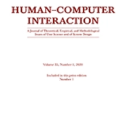Finger-Fitts law (FFitts law) is a model to predict touch-pointing times modified from Fitts' law. It considers the absolute touch-point precision, or a finger tremor factor sigma_a, to decrease the admissible target area and thus increase the task difficulty. Among choices such as running an independent task or performing parameter optimization, there is no consensus on the best methodology to measure sigma_a. This inconsistency could be harmful to HCI studies such as evaluating pointing techniques and comparing user groups. By integrating the results of our 1D and 2D touch-pointing experiments and reanalyses of previous studies' data, we examined the advantages and disadvantages of each approach to compute sigma_a, and we found that using the parameter optimization method has overall the best prediction performance.
翻译:手指法( FFFitts law) 是预测从Fitts 法中修改的触摸点时间的模型。 它考虑绝对触摸点精确度或手指颤抖系数Sigma_a, 以减少可允许的目标区域, 从而增加任务难度。 在独立执行任务或进行参数优化等选择中, 对于衡量 sigma_a 的最佳方法没有共识。 这种不一致可能有害于 HCI 研究, 如评估指针技术和比较用户组。 通过整合我们的1D 和 2D 触摸点实验的结果以及重新分析先前研究的数据, 我们研究了计算 sigma_a 的每一种方法的利弊。 我们发现, 使用参数优化方法总而言而言而言, 具有最佳的预测性能 。




